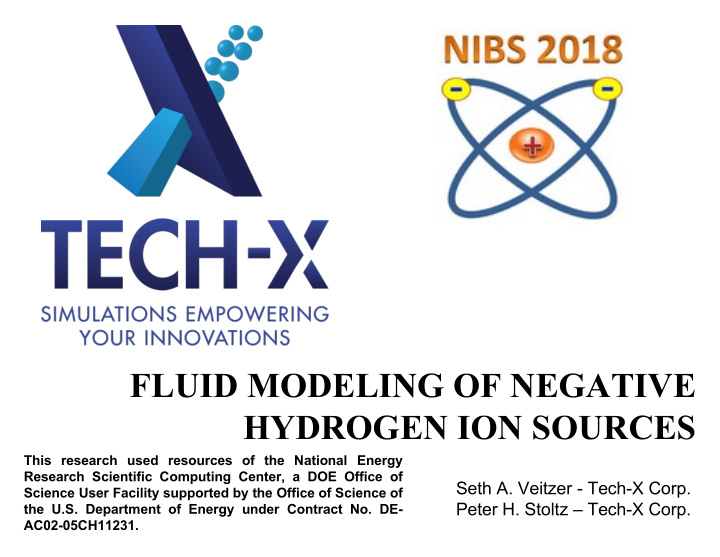



FLUID MODELING OF NEGATIVE HYDROGEN ION SOURCES This research used resources of the National Energy Research Scientific Computing Center, a DOE Office of Seth A. Veitzer - Tech-X Corp. Science User Facility supported by the Office of Science of Peter H. Stoltz – Tech-X Corp. the U.S. Department of Energy under Contract No. DE- AC02-05CH11231.
We are using a plasma fluid modeling tool to simulate the performance of ion sources A computational fluid dynamics We have used USim to model (CFD) code, unstructured plasma interaction with antenna surfaces in SNS H - ion source; meshes, charged or neutral fluids Help improve internal antenna design for improved reliability at SNS SIMULATIONS EMPOWERING YOUR INNOVATIONS
We have developed two models for ion sources in USim Multi-fluid electromagnetic Multi-fluid drift-diffusion Multi-fluid, electrostatic Multi fluid, spectral EM Appropriate to lower density Appropriate to higher density, ICP Computationally simple Computationally intensive Today’s presentation Discussed at NIBS 2016 SIMULATIONS EMPOWERING YOUR INNOVATIONS
USim solves flux-conservative equation sets using finite volume algorithms One example is convective drift equations*: Many of the USim algorithms are described in detail in this book *USim includes non-hyperbolic terms, like diffusion, separately with algorithms like STS SIMULATIONS EMPOWERING YOUR INNOVATIONS
Drift-diffusion models are most applicable when electron-neutral collisions dominate The drift-diffusion model works best with: - High pressure (collision frequency larger than plasma frequency implies v ~ E) - Low voltage (drift velocity smaller than thermal velocity implies v ~ E) - Low plasma density (Debye length long implies field penetrates into plasma) For example, assuming: T e ~ 4 eV, v th =10 6 m/s, E ~ 1 kV/m, 𝜏 elastic = 10 -19 m -2 Neutral Collision Mean Free Electron Drift Plasma Plasma Debye Drift pressure frequency Path Velocity density frequency length diffusion (torr) (s -1 ) (m) (m/s) (m -3 ) (s -1 ) (m) applicable? 10 3x10 10 30x10 -6 10 4 10 12 10 7 0.01 Y 0.1 3x10 8 3x10 -3 10 6 10 14 10 8 0.001 Maybe 0.01 3x10 7 0.03 10 7 10 15 3x10 8 3x10 -4 N SIMULATIONS EMPOWERING YOUR INNOVATIONS
The USim model solves the full drift diffusion equation with sources ● USim includes an RK-like super-time-stepping scheme for stepping over diffusion time scales ● USim can also include any number of ion species in the same way SIMULATIONS EMPOWERING YOUR INNOVATIONS
Drift-diffusion model includes joule heating, ionization and excitation through source terms ionization density source convective diffusive joule ionization energy joule heating heating losses ● We can track an arbitrary number of these reactions ● k can be temperature dependent SIMULATIONS EMPOWERING YOUR INNOVATIONS
As a test-bed for this model, we use a rectangular region of constant gas density and electric field boundary simulation domain conditions p = 0.1 Torr N 0 =3.0x10 21 m -3 constant supply of n e E 0 =1.0 kV/m v d ~10 6 m/s ● We assume a reservoir of electrons with n e ~ 5.0x10 12 m -3 and Te = 2 eV on the left boundary SIMULATIONS EMPOWERING YOUR INNOVATIONS
First test case includes H 2 ground state impact ionization Electron Density Electron Temperature ● We evolve system to steady steady (a few electron crossing times) ● Ionization adds density, diffusion acts to smooth ● Ionization energy loss acts to cool the plasma SIMULATIONS EMPOWERING YOUR INNOVATIONS
Reaction Sources SIMULATIONS EMPOWERING YOUR INNOVATIONS
We perform simulations with reaction sources in a system similar to our previous simulations boundary simulation domain conditions p = 0.1 Torr N 0 =3.0x10 21 m -3 constant supply of n e E 0 =1.0 kV/m v d ~10 6 m/s ● We assume a reservoir of electrons with n e ~ 5.0x10 12 m -3 and Te = 2 eV on the left ● Add reactions ● Increase physical dimensions SIMULATIONS EMPOWERING YOUR INNOVATIONS
Results with Ionization and Dissociation H + T e t = 0.7 µ s H - n e SIMULATIONS EMPOWERING YOUR INNOVATIONS
Results with Ionization and Dissociation and Vibrational Creation of H - H + T e Numerical instabilities are developing at the boundary t = 2.0 µ s H - n e SIMULATIONS EMPOWERING YOUR INNOVATIONS
Conclusions and Next Steps • We can use fluid models to simulate negative hydrogen ion sources with realistic plasma chemistry (an ongoing effort!) • In some cases, a drift diffusion model is appropriate for this modeling • 2-Dimensional cylindrical modeling with Hydrogenic chemistry -- Include RF power deposition • -- Include wall production of H - • Deuterium plasma chemistry? • Alternative Methods for speeding up ion source simulations, for instance, ECRs • -- Speed Limited Particle-In-Cell Algorithms SIMULATIONS EMPOWERING YOUR INNOVATIONS
Next Steps S PEED -L IMITED P ARTICLE -I N -C ELL M ODELING OF P LASMAS : SPEEDING UP PIC MODELING BY SLOWING DOWN PARTICLES Thomas G. Jenkins with Andrew M. Chap John R. Cary Tech-X Corporation Gregory R. Werner University of Colorado-Boulder Tech-X Worldwide Simulation Summit Funded by U.S. Department of Energy, Boulder, Colorado SBIR Phase I/II Award DE-SC0015762 August 21, 2018 ● Fastest electrons set the timestep in PIC, even if their kinetics are not of interest ● SLPIC formalizes how to transform PIC equations of motion so that fast particles are accurately simulated without excessive time step restrictions SIMULATIONS EMPOWERING YOUR INNOVATIONS
Recommend
More recommend